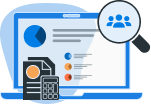What Is a Learning Style?
A learning style refers to the preferred way an individual absorbs, processes, and retains information. People have unique ways of interacting with and understanding new material. While some might prefer hands-on learning, others might favor reading or listening. Understanding these preferences allows employers and HR professionals to design training programs that resonate with their employees, ultimately improving learning outcomes and job performance.
Why Is Learning Style Important in the Workplace?
The concept of learning style is crucial for several reasons:
Enhanced Retention
When employees engage with training materials that match their learning preferences, they are more likely to retain the information.
Improved Performance
By aligning training methods with how employees learn best, you ensure they are equipped to perform tasks more effectively.
Employee Engagement
Tailored learning experiences boost engagement by making training feel more relevant and personalized, leading to higher motivation levels.
Diverse Learning Needs
In a workplace with a diverse team, different learning styles are inevitable. By acknowledging these differences, companies create inclusive training programs that address everyone's needs.
The Different Types of Learning Styles
There are several models of learning styles, but one of the most commonly referenced is the VARK model, which categorizes learning preferences into four main types: Visual, Auditory, Reading/Writing, and Kinesthetic. Let’s take a look at each of these in more detail.
1. Visual Learners
Visual learners are individuals who best understand and retain information through visual aids such as charts, graphs, diagrams, and videos. They thrive when training materials are accompanied by visuals that help them see relationships between concepts.
How to Support Visual Learners:
- Incorporate infographics, flowcharts, and videos into training sessions.
- Use color-coding techniques to highlight key information.
- Provide written instructions and visual diagrams that explain processes step-by-step.
2. Auditory Learners
Auditory learners absorb information best through listening. They are likely to retain information from discussions, lectures, podcasts, or verbal instructions. These learners thrive in environments where they can listen and engage in dialogue.
How to Support Auditory Learners:
- Use audio recordings and podcasts to reinforce learning.
- Encourage discussions, brainstorming sessions, and verbal feedback.
- Organize group activities where employees can verbalize their ideas and engage in conversation.
3. Reading/Writing Learners
Reading/Writing learners excel when they can read and write about concepts. They prefer written information such as articles, reports, and manuals. For them, writing summaries or taking notes helps reinforce learning.
How to Support Reading/Writing Learners:
- Provide written materials like manuals, case studies, and reports.
- Allow learners to take notes during presentations or training sessions.
- Encourage the use of written exercises such as quizzes, reports, or written reflections.
4. Kinesthetic Learners
Kinesthetic learners are hands-on individuals who learn best by physically engaging with tasks. These learners benefit from activities that involve movement, practical exercises, and role-playing scenarios. They find it easier to retain knowledge when they can experience it firsthand.
How to Support Kinesthetic Learners:
- Design interactive training sessions that include physical activities, simulations, or role-playing.
- Offer opportunities for employees to engage with real-world tasks during training.
- Use activities like team-building exercises or job rotations to provide practical experiences.
How to Identify Learning Styles in Your Employees
As an HR professional, recognizing the learning styles of your team members is essential to creating an effective training program. Here are a few strategies to help you identify the learning preferences of your employees:
1. Observe Their Behavior
Watch how employees engage with training materials. Do they take a lot of notes? Do they prefer working with their hands or discussing ideas in a group setting? Observing these behaviors can give you insight into their preferred learning style.
2. Conduct Learning Style Assessments
Many companies use learning style assessments or quizzes to help employees identify their preferred learning method. You can provide these assessments at the beginning of the training program to personalize their learning experience.
3. Ask Directly
Sometimes, the best way to understand an employee’s learning style is to ask them directly. Conduct one-on-one conversations or surveys to learn how they feel they learn best. This feedback helps tailor future training programs to meet their needs.
Benefits of Adapting to Different Learning Styles
By recognizing and adapting to different learning styles, your company can experience numerous benefits, including:
1. Improved Employee Performance
Employees who receive training in a way that suits their learning style are more likely to succeed in their roles. For example, visual learners will retain information better through diagrams, while kinesthetic learners will excel in hands-on tasks.
2. Increased Job Satisfaction
When employees feel that their learning preferences are acknowledged, they are more likely to feel valued and engaged. This can lead to higher job satisfaction, which ultimately impacts retention rates.
3. Enhanced Team Collaboration
Understanding diverse learning styles fosters an environment of inclusivity and collaboration. When teams are trained using varied methods, employees are more likely to learn from each other, combining strengths and offering unique perspectives.
4. More Efficient Training Programs
By tailoring training programs to different learning styles, you can create more efficient programs. Employees can grasp concepts more quickly, resulting in a faster onboarding process and improved productivity.
Strategies for Implementing Learning Styles in HR Training Programs
Now that we’ve covered the importance of understanding learning styles, let’s look at how to effectively integrate them into your HR training programs.
1. Create Blended Learning Programs
A blended learning approach combines various methods such as online courses, in-person workshops, and hands-on practice to cater to a wide range of learning preferences. For example, you might offer video tutorials (visual), podcasts (auditory), reading materials (reading/writing), and practical exercises (kinesthetic) in one training program.
2. Offer Multiple Learning Pathways
Incorporate a mix of learning modalities so employees can choose the path that best suits them. For example, you can provide options for visual learners to watch instructional videos or for kinesthetic learners to engage in interactive workshops.
3. Encourage Peer Learning
Peer learning allows employees to share their expertise and learning preferences with each other. Organizing group discussions or mentorship programs can help employees with different learning styles collaborate, offering diverse insights.
4. Use Technology to Personalize Training
Today’s HR technology allows you to track learning preferences and create personalized learning paths. Learning management systems (LMS) can store information about each employee’s learning style and suggest relevant resources, allowing employees to progress at their own pace.
Overcoming Challenges in Addressing Learning Styles
While it’s important to embrace learning styles, it can be challenging to address every individual’s preference. The key is to balance personalized approaches with group-based learning. You may encounter the following challenges:
1. Limited Resources
Providing tailored learning experiences can require additional time and resources. However, the benefits of improved retention, engagement, and performance outweigh the initial investment.
2. Resistance to Change
Employees might be used to traditional methods of training, and shifting to a more personalized approach could face resistance. It’s essential to communicate the value of these changes and how they benefit both employees and the organization.
3. One-Size-Fits-All Solutions
While it’s tempting to design a “one-size-fits-all” training program, such approaches often fail to engage employees with different learning preferences. To overcome this, blend multiple methods to address diverse needs.
Are you ready to boost your team's performance by tailoring training to their learning styles? Start by assessing your employees' learning preferences today, and watch your training programs become more effective and engaging. Need help designing your employee development strategy? Get in touch with Qandle today, and let's create a customized solution that works for your organization!


 Back to Glossary
Back to Glossary